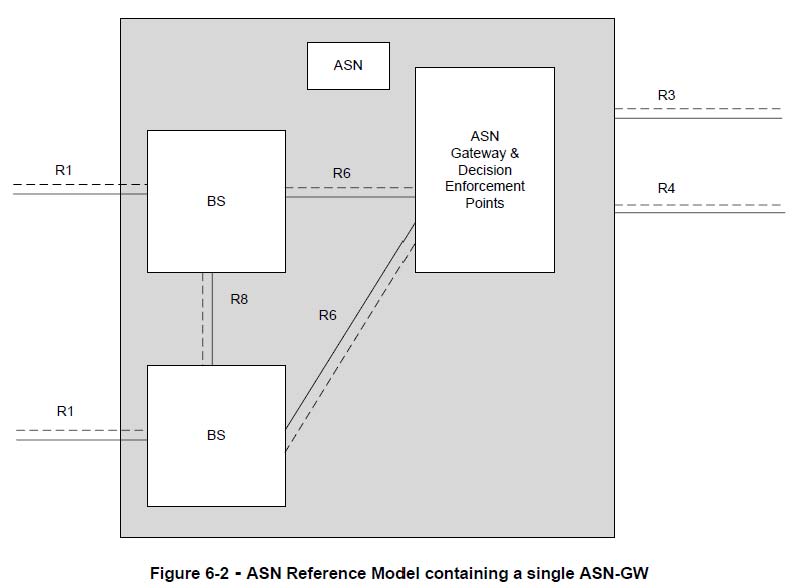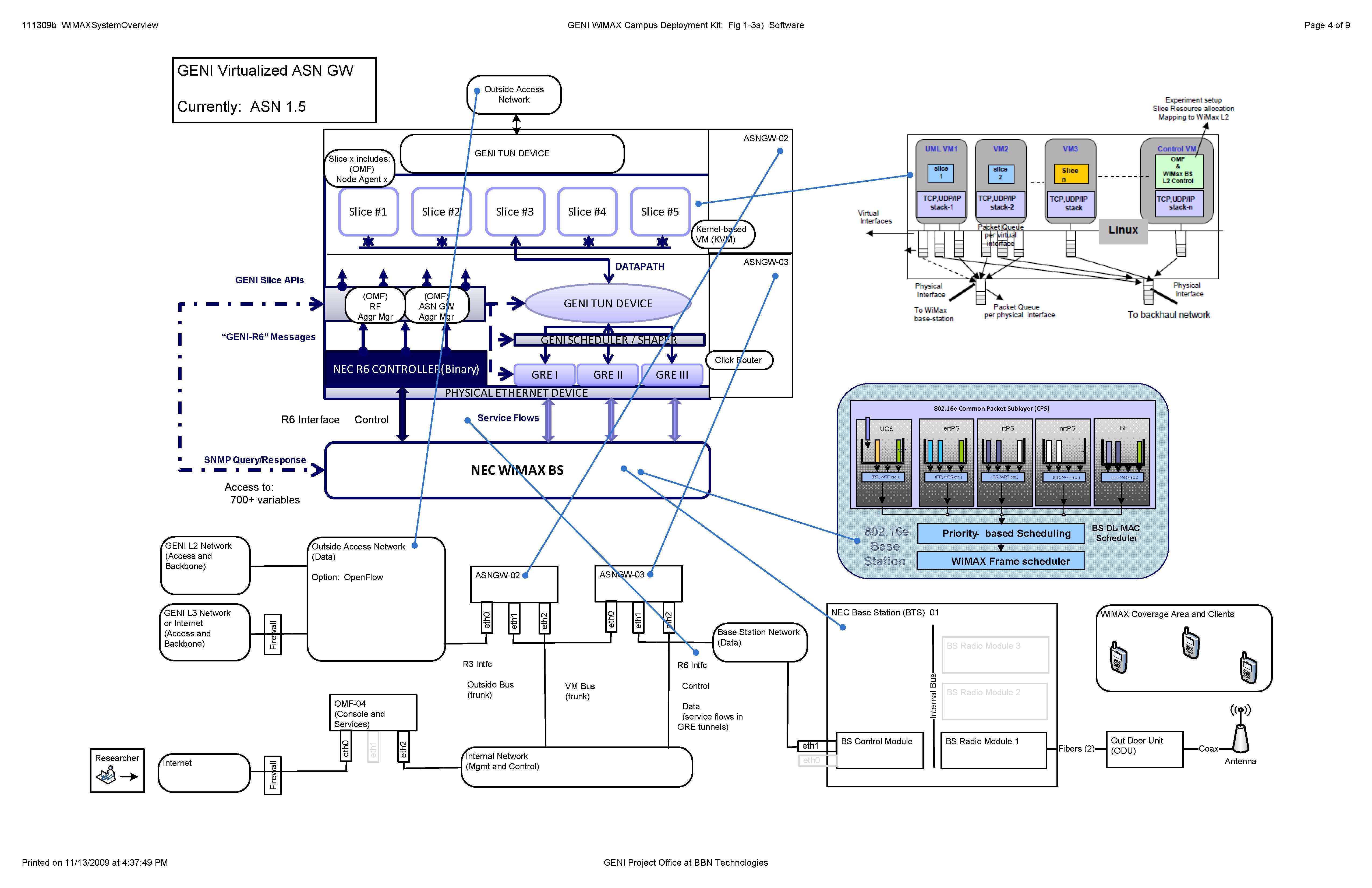| Version 128 (modified by , 14 years ago) (diff) |
|---|
WiMAX Meso-Scale Deployment Integration
1. Projects
Campus deployment projects:
WiMAX at BBN Technologies
WiMAX at Columbia University
WiMAX at Polytechnic Institute of NYU
WiMAX at UCLA
WiMAX at University of Colorado at Boulder
WiMAX at UMass Amherst
WiMAX at University of Wisconsin
Open GENI WiMAX Base Station Kit for Campus Deployments
WIMAX Design and Prototype
ORBIT Design and Prototype
OMF (cOntrol and Management Framework)
ORBIT Testbed
GENI Projects at WINLAB
Process for updating Milestones, submitting QSRs
2. Meetings and Demos
Suggested mailing lists for Cluster E and WIMAX Integration participants:
GENI mailing lists, including the dev, discuss and geni-announce lists, plus working groups that cover your interests.
mail to cluster-e-admin@winlab.rutgers.edu for PIs. / subscribe / mailman archieve
mail to cluster-e-user@winlab.rutgers.edu for users / subscribe / mailman archieve
WiMAX Base Station Demo at GEC 6, November 17, 2009
Cluster E and WiMAX Deployment Call on February 8, 2010
[ Cluster E and WiMAX Deployment Call on March 1, 2010]
Cluster E and WiMAX Deployment Meetings at GEC7 March 16 and 17, 2010
[ "WiMAX Base Station Demo at GEC 7, March 16, 2010"]
3. References and Documents
WiMAX Concepts and RF Measurements, IEEE 802.16-2004 WiMAX PHY layer operation and measurements, Hewlett Packard Application Note
WiMAX Forum
WiMAX Forum Technical Specifications
WiMAX Forum Network Architecture Release 1.0 Version 4 - Stage 2: Architecture Tenets, Reference Model and Reference Points
GENI WiMAX Project: System Engineering Summary
API Specification for Virtualized WiMAX Basestation
D. Raychaudhuri and Editors M. Gerla, “New architectures and disruptive technologies for the future internet: The wireless, mobile and sensor network perspective” Report of NSF Wireless Mobile Planning Group (WMPG) Workshop, August 2005
Open Base Station Architecture Initiative
“Android: An Open Handset Alliance Project"
”NEC’s broadband wireless access products”, NEC Corporation Technical White Paper
“Wireless virtualization in GENI”, GDD-06-17, 2006
- Paul, R. Yates, D. Raychaudhuri and J. Kurose, "The Cache-and-Forward Network Architecture for Efficient Mobile Content Delivery Services in the Future Internet", to appear in ITU-T Next Generation Networks (NGN) Conference, Geneva, May 2008.
OMF (cOntrol and Management Framework)
ORBIT Testbed
Current OMF documents
Cluster E Overview Drawing
ORBIT diagram
ORBIT Connectivity
(WiMAX connectivity from WINLAB follows ORBIT connectivity)
OML is a measurement library developed in the context of OMF.
OML Overview (wiki)
OML Overview (slides)
4. System Engineering
Ongoing WiMAX standards work is done by the WiMAX Forum. See, for example, the WiMAX Forum Technical Specifications
An technical overview of WiMAX network architecture is presented in WiMAX Forum Network Architecture Release 1.0 Version 4 - Stage 2: Architecture Tenets, Reference Model and Reference Points, including:
Fig 6-1) Network Reference Model
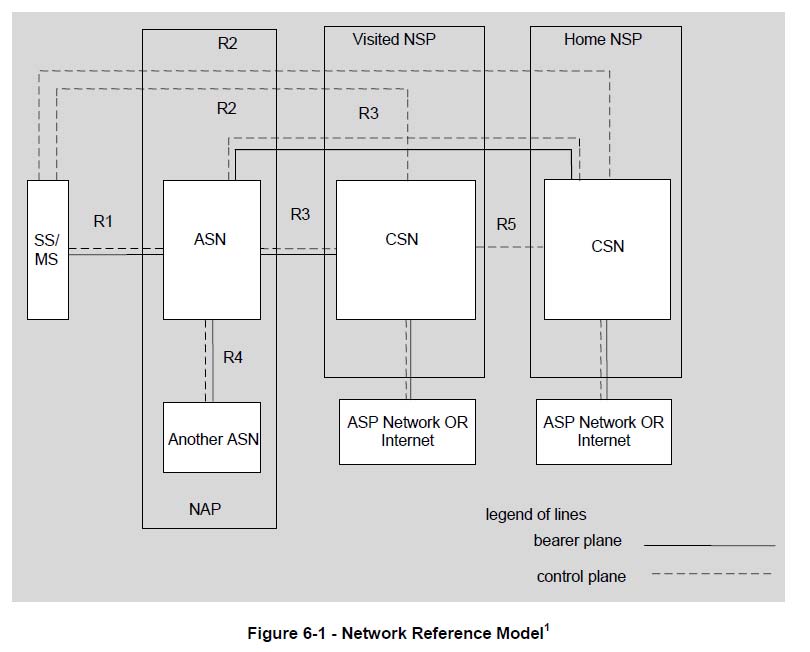
A technical overview of the GENI WiMAX project is presented in: GENI WiMAX Project: System Engineering Summary.
The GENI WiMAX project currently utilizes commercial NEC WiMAX equipment as the basis of its WiMAX campus deployment kit, including a Profile A Base Station and a separate ASN Gateway, joined by the R6 interface, per Figure 6-2, above. The R6 interface implementation is not fully standardized, and thus includes NEC-specific functions.
For the GENI WiMAX project, the WiMAX campus deployment kit provides the GENI Researcher with much flexibility:
The use of a Profile A Base Station with an exposed R6 interface enables the researcher to monitor and control the base station radio functions.
The ASN gateway utilizes some essential NEC code, but removes many high-level WiMAX functions (e.g., roaming) and allows the researcher to implement their own.
Finally, the ASN gateway includes slicing functions, to allow the base station and ASN gateway to be shared by multiple researchers at the same time.
Later in 2010, NEC will be updating their WiMAX equipment to utilize a Profile C Base Station, where some of the current ASN gateway functions are included in the Base station, and fully standardized R6 interface is exposed. When this occurs:
The current GENI-specific ASN gateway software will have to be modified, with an effort of at leat 2 MM.
The researcher will have diminished ability to monitor and control the base station radio functions.
System engineering issues:
| No | Issue | Who | Opened | Resolved | Resolution | Note |
| 4.1 | "GENI WiMAX" ID: Each WiMAX deployment requires an ID, a parameter used within the base station and each client. Currently, Routgers WINLAB is using the Sprint/Clearwire ID, but this can only be temporary. We need to apply for and receive a "GENI WiMAX" ID. | Michel, Seskar | 12/09 | - | - | Where do we apply? Are there any barriers? |
| 4.2 | Range and capacity: Need to be able to estimate the expected range and capacity of a completed installation, and how this varies with antenna height, to guide each campus in their planning. Also, how this varies depending on the number of clients and their data rates. | Michel, Seskar | 12/09 | - | - | Seskar: Have some data from Rutgers WINLAB site, and expect more when Rutgers Bush Campus site is in service. |
| 4.3 | GPS receiver: NEC documentation shows a GPS receiver mounted along with the antenna, and connected to the NW INTFC on the IDU. What is this used for? Should we include it with the kit? How much would it cost? If we do not include it, what will be be missing? | Rangarajan, Seskar | - | - | - | - |
| 4.4 | - | - | - | - | - | - |
| 4.5 | - | - | - | - | - | - |
5. GENI D&P WiMAX Infrastructure Buildout
The overall GENI buildout plan is funded by an NSF contract, and is summarized in GENI D&P WiMAX Infrastructure Buildout.
It includes a map of the participating campuses:

And a list of involved researchers and IT leaders:
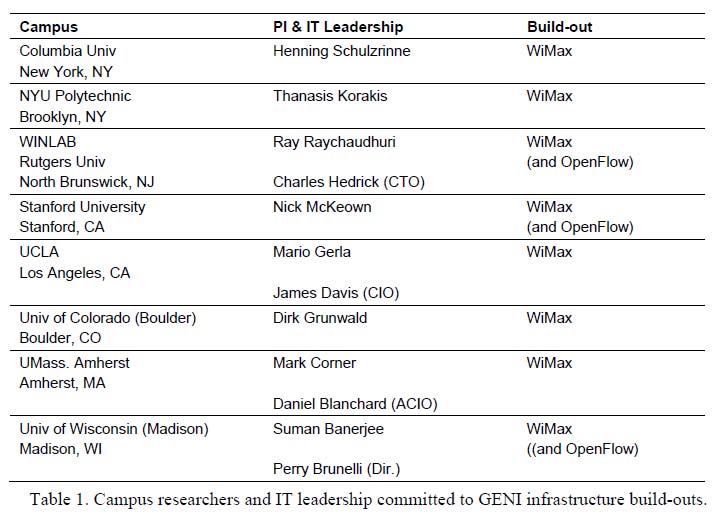
The WiMAX Kit Project (1753) outlined the usage plans for each campus:
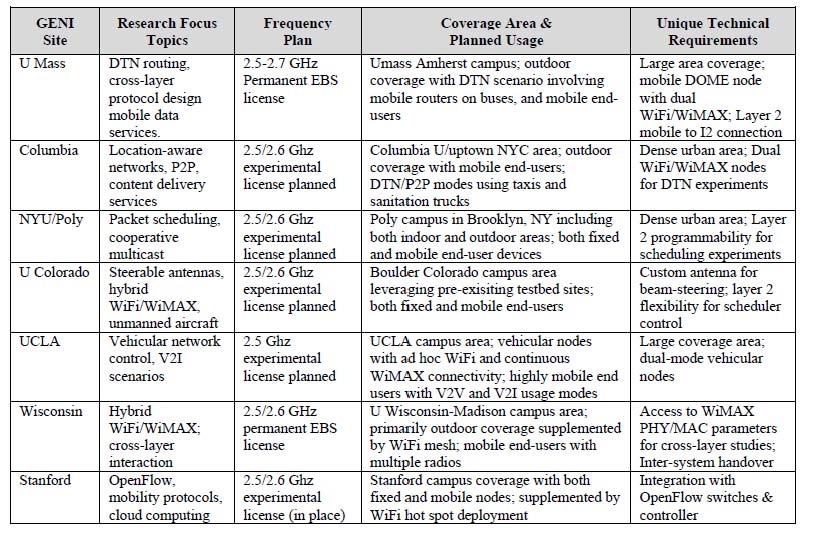
As part of the Spiral 1 WiMAX D&P prject, two WiMAX campus deployment kits were purchased for:
Rutgers, WINLAB
Rutgers, Bush Campus
The WiMAX Kit Project (1753) is purchasing and supplying WiMAX campus deployment kits to the following campuses. In addition, it is providing a limited number of client platform kits.
NEC Labs America
Columbia University
Polytechnic Institute of NYU
UCLA
University of Colorado at Boulder
UMass Amherst
University of Wisconsin
The following campus purchased their own kit;
Stanford
In addition, the following additional GENI-related campuses and sites may separately purchase the necessary equipment to build their own WiMAX campus deployment kits, and then deploy them with aid from the GPO and Rutgers WINLAB:
BBN Technologies
University of Wisconsin, 2nd site?
other?
Buildout issues:
| No | Issue | Who | Opened | Resolved | Resolution | Note |
| 5.1 | Who wants additional kits: We need to compile a list of GENI-related campuses and sites that want to purchase the necessary equipment to build their own WiMAX campus deployment kits. Current list: BBN Technologies (firm); University of Wisconsin, 2nd site (?); other? | Mussman | 12/09 | - | - | We need this to be firm by 3/31/10, to be ready to place the order. |
| 5.2 | How to order additional kits: We need to understand how to order the key components from NEC for a WiMAX campus deployment kit, both BofM and process. | Rangarajan | 2/10 | - | - | We need this by 3/31/10, to be ready to place the order. |
| 5.3 | - | - | - | - | - | - |
| 5.4 | - | - | - | - | - | - |
| 5.5 | - | - | - | - | - | - |
6. WiMAX Campus Deployment Kit
6.1 Configuration
Fig 1-2a) Hardware and Networking
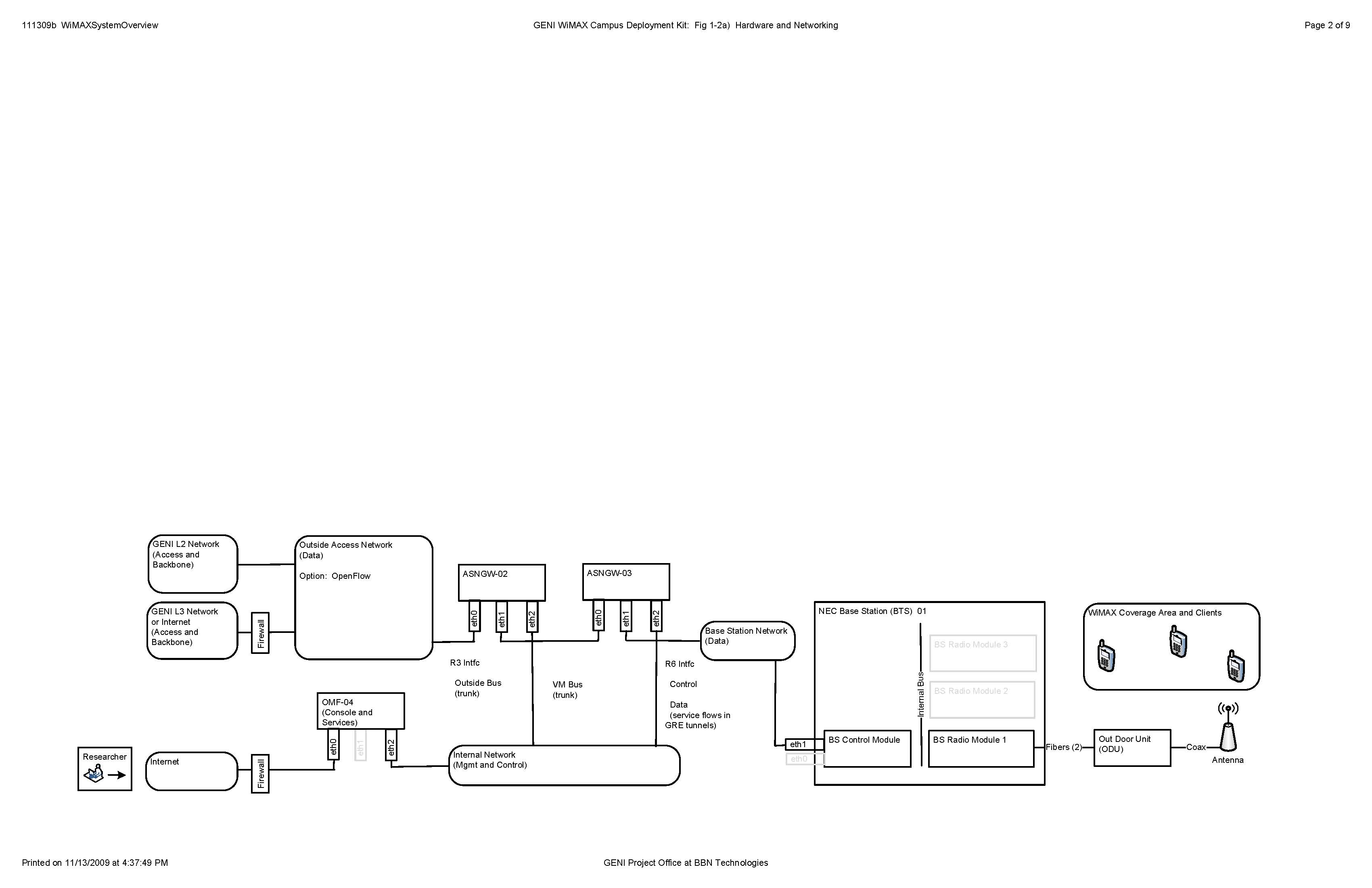
Figure 1-2a) shows the full configuration with three servers:
ASNGW-03, that provides combined ASN GW functions.
ASNGW-02, that provides virtualized ASN GW functions, for separate slices.
OMF-04, that provides a set of OMF/OML functions.
In some cases, a campus already has a set of OMF/OML functions, and would likely not require the OMF-04 server:
Rutgers, WINLAB
Rutgers, Bush Campus
Polytechnic Institute of NYU
For the initial bringup, it should be possible to load all functions into one server.
Issue: Are there campuses that can complete their expected experiments operating with only one server? two servers?
6.2 NEC Hardware
Fig 1-2b) NEC BTS IDU, ODU and Antenna
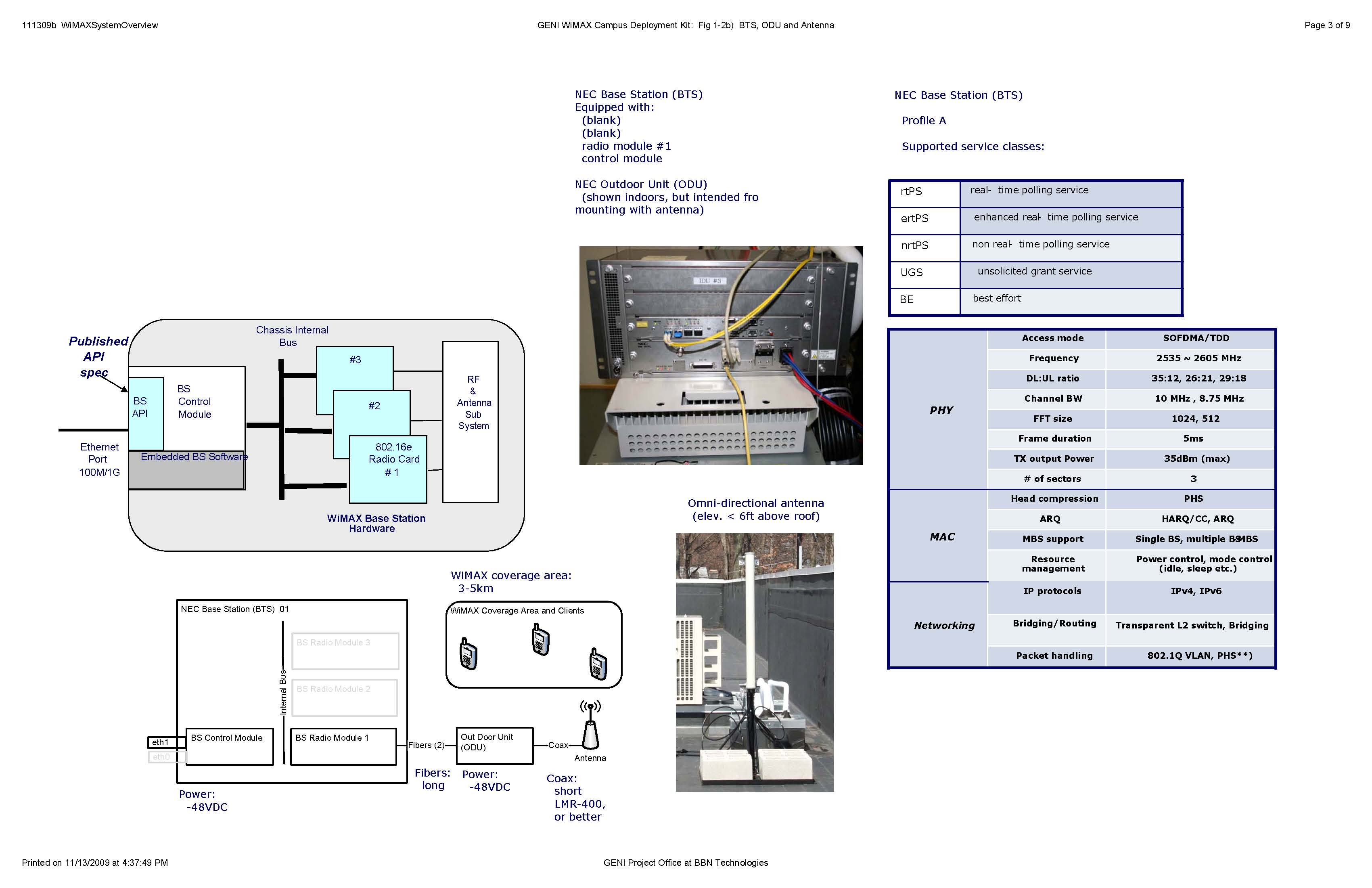
6.3 -48VDC Power
Both the NEC ODU and IDU are, as telecom systems, powered by a -48VDC power source.
It is recommended that two separate -48VDC power supplies, with 110VAC feeds, be provided, one for each unit. This avoids the need for a -48VDC distribution panel, with circuit breakers, and yet still allows individual control for each unit. Furthermore, it allows the power supply for the ODU to be mounted in a weathertight box on the roof, if that is preferred to mounting with the indoor testbed equipment.
Power feed connections are outlined in the NEC Installation Manual for Base Station (IMN:BS)
The recommended configuration for the ODU is:
ODU mounted outdoors, on roof, with maximum of 4A required at -48VDC
One 10m (approx 30ft) outdoor power cable, two conductors, 12AWG, rated for outdoor use, with ODU Circular Connector, soldered onto cable.
One power supply for ODU, Mean Well SP-200-48, 110VAC input, -48VDC output, rated 4.2A or 200W, mounted in testbed equipment room, or outdoors on roof, in weathertight enclosure (see UMass Amherst).
The recommended configuration for the IDU is:
IDU mounted indoors, in testbed equipment room, with maximum of 8.4A required at -48VDC (in full configuration with all 3 sector boards).
One 10m (approx 30ft) indoor power cable, two conductors, 10AWG, with one IDU Rectangular Power Connector and four IDU Rectangular Power Connector Contacts , two for each of the positive and negative DC power rails, crimped onto cable with a special tool, or soldered.
One power supply for IDU, Mean Well SP-320-48, 110VAC input, -48VDC output, rated 6.7A or 320W, mounted in tesbed equipment room.
6.4 Software Modules
6.5 Messages and APIs
6.6 Virtualization
6.7 Control and Management
Fig 1-5) Control and Management

6.8 Federation
During initial bringup, each WiMAX testbed will operate as a self-contained OMF-controlled testbed.
Then, various WiMAX testbeds will be federated, by implementing:
Coordinated OMF control of two or more testbeds by one experimenter.
Connecting experiment data from testbeds together, using a VLAN carried by a GENI backbone.
Issue: How will federation among WiMAX testbeds be accomplished?
Issue: How will WiAMX tesbeds be connected together, using a VLAN carried by a GENI backbone?
6.9 Kit Bill of Materials
The following WiMAX base station kit items are supplied by NEC.
For the six WiMAX campus deployment projects, they will be purchased by Rutgers WINLAB as part of the WiMAX kit project, and provided to the campus projects.
For the additional campuses, sites, they will be purchased by the campus directly from NEC.
| Item | Supplier | Part No | Description | Qty | Cost Each | Cost Total | Note |
| 1.1 | NEC | NWA-025035-001 | 2.5GHz SECTOR ANT: Antenna, dual-polarization, omnidirectional antenna, for operation in the 2.5GHz range. | 1 | - | - | - |
| 2.1 | NEC | NWA-027932-001 | NEC 2.5GHz ODU: Base Station Outdoor Unit, for connection to one antenna. | 1 | - | - | - |
| 3.1 | NEC | NWA-024297 | IDU: Base Station Indoor Unit, equipped equipped for 1-Sector Configuration, with one Network Interface (NW INTFC) card and one Channel Card (CHC). | 1 | - | - | - |
| 3.2 | NEC | - | Network Interface (NW INTFC) card | 1 | - | - | - |
| 3.3 | NEC | - | Channel Card (CHC) | 1 | - | - | - |
| 4.1 | NEC | - | 100m (approx 300ft) of dual fiber cable, rated for outdoor mounting, yellow SM, with connectors | 1 | - | - | - |
The following WiMAX base station kit items have a variety of suppliers.
For the six WiMAX campus deployment projects, they will be purchased by Rutgers WINLAB as part of the WiMAX kit project, and provided to the campus projects.
For the additional campuses, sites, they will be purchased by the campus (or provided by Rutgers WINLAB for convenience).
| Item | Supplier | Part No | Description | Qty | Cost Each | Cost Total | Note |
| 5.1 | - | - | 1m (approx 3ft) (or as needed) antenna cable, LMR300 (or LMR400) coax, with N connectors | 1 | - | - | - |
| 5.2 | - | - | Lightning arrestor, for use with ODU antenna cable connection | 1 | - | - | - |
| 6.1 | - | - | 10m (approx 30ft) outdoor power cable, two conductors, 12AWG, rated for outdoor use, with ODU Circular Connector, soldered onto cable | 1 | - | - | - |
| 6.2 | Mouser: Hirose | JR25WP-4S71 | ODU Circular Connector | 1 | - | - | - |
| 6.3 | - | - | Additional outdoor power cable, as needed, two conductors, 12AWG, rated for outdoor use, to extend from roof down to indoor testbed equipment room | ? | - | - | - |
| 7.1 | - | - | 10m (approx 30ft) indoor power cable, two conductors, 10AWG, with one IDU Rectangular Power Connector and four IDU Rectangular Power Connector Contacts , two for each of the positive and negative DC power rails, crimped onto cable with a special tool, or soldered. | 1 | - | - | - |
| 7.2 | Mouser: Tyco/Amp | 1-917807-2 | IDU Rectangular Power Connector | 1 | - | - | - |
| 7.3 | Mouser: Tyco/Amp | 316041-2 | IDU Rectangular Power Connector Contacts | 4 | - | - | - |
| 8.1 | - | - | Server, loaded with ASN-GW and ORBIT Management Framework software, for use during installation and initial checkout, and perhaps for final operating configuration | 1 | - | - | - |
The following tools will be provided on-loan to campuses by Rutgers WINLAB, for use with Tyco/Amp power connectors:
Crimping tool for D-5 Series
Pin extraction tool for D-5 Series
The following WiMAX base station kit items have a variety of suppliers, and are purchased by each campus:
| Item | Supplier | Part No | Description | Qty | Cost Each | Cost Total | Note |
| 9.1 | - | - | Outdoor site, with pole for mounting of antenna and Base Station Outdoor Unit, grounded to building ground for lightening protection | 1 | - | - | In some locales, the installation and grounding will need to be certified by a professional engineer |
| 9.2 | - | - | Pole for mounting of antenna and Base Station Outdoor Unit | 1 | - | - | Pole diameter between 48mm and 120mm |
| 9.3 | - | - | Ground cable, as needed. | 1 | - | - | - |
| 10.1 | Mouser: Mean Well | SP-240-48 | Power supply for ODU, Mean Well SP-200-48, 110VAC input, -48VDC output, rated 4.2A or 200W, mounted in testbed equipment room, or outdoors on roof, in weathertight enclosure (see UMass Amherst) | 1 | - | - | - |
| 10.2 | - | - | As needed, one weatherproof container on roof, to mount ODU power supply. | ? | - | - | see UMass Amherst |
| 11.1 | - | - | Indoor site, with racks, for mounting of Base Station Indoor Unit and Linux Servers | 1 | - | - | - |
| 11.2 | Mouser: Mean Well | SP-320-48 | Power supply for IDU, Mean Well SP-320-48, 110VAC input, -48VDC output, rated 6.7A or 320W, mounted in testbed equipment room | 1 | - | - | - |
| 11.3 | - | - | Servers, for loading with ASN-GW and ORBIT Mangement Framework software, for final operating configuration | 0 - 3 | 1,600 | 0 - 4,800 | Depends on final configuration |
| 11.4 | - | - | Ethernet switch ports for multiple VLANs | - | - | 0 - 2,500 | OpenFlow compatible switch desired; PC-based design underway that utilizes FPGA card, total value: $1300 + $400 = $1700 |
6.10 Kit Hardware, Integration and Delivery
The WiMAX Kit Project (1753) divided up projects tasks this way:
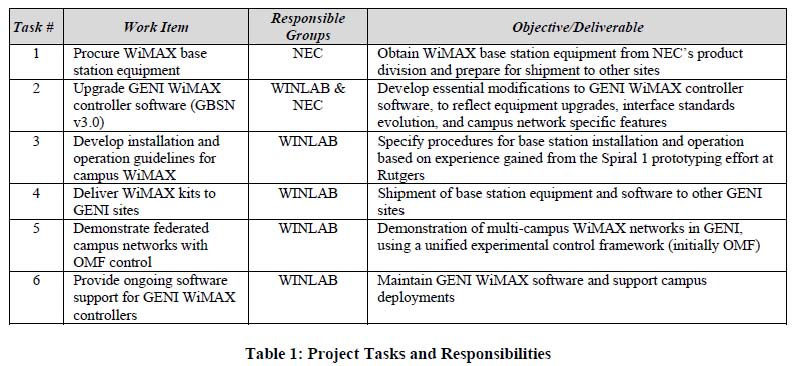
The WiMAX Kit Project (1753) established this high-level schedule:

Software releases follow this plan:
| Release | Features | Released | Delivered | Where | Note |
| v1.0 | - | Plan 10/1/09 (Spiral 1) | - | Rutgers WINLAB | For first demos and experiments |
| v2.0 (GBSN v3.0) | - | Plan 7/15/10 (Spiral 2) | - | - | For use in first delivered kits |
| v2.1 (GBSN v3.1) | - | Plan 11/2010 (Spiral 3) | - | - | - |
| v2.2 (GBSN v3.2) | - | (Spiral 4) | - | - | - |
The first sets of kit hardware were ordered in 2008 and delivered in 2009, as part of Spiral 1:
| Kit | Ordered | Received | Integrated | Delivered | Where | Note |
| 1.1 | 2008 | 2009 | 2009 | 2009 | Rutgers, WINLAB | p/o ORBIT testbed |
| 1.2 | 2008 | 2009 | 2009 | 2/2010 | Rutgers, Bush Campus | applications |
The second sets of kit hardware were ordered in 2009 and will be delivered in 2010, as part of Spiral 2:
| Kit | Ordered | Received | Integrated | Delivered | Where | Note |
| 2.1 | 12/17/09 | plan 5/15/10 | ? | ? | NEC Labs America | ? |
| 2.2 | 12/17/09 | plan 5/15/10 | ? | ? | Columbia University | ? |
| 2.3 | 12/17/09 | plan 5/15/10 | ? | ? | Polytechnic Institute of NYU | ? |
| 2.4 | 12/17/09 | plan 5/15/10 | ? | ? | UCLA | ? |
| 2.5 | 12/17/09 | plan 5/15/10 | ? | ? | University of Colorado at Boulder | ? |
| 2.6 | 12/17/09 | plan 5/15/10 | ? | ? | UMass Amherst | ? |
| 2.7 | 12/17/09 | plan 5/15/10 | ? | ? | University of Wisconsin | ? |
Issue: It has been planned that three kits will be delivered during Spiral 2, and the remaining four during Spiral 3. It has been planned that the first three kits will be delivered to campuses/sites where there is easy access for support, i.e., at nearby locations: NEC Labs America, Columbia University, and Polytechnic Institute of NYU. However, it would also make sense to deliver a kit ONLY when the campus/site has received an FCC license, and is ready to install the kit. Thus, the delivery sequence may also depend on campus status.
It is expected that a third sets of kit hardware will be ordered in 3/2010 and will be delivered in ?, for those campuses not included in the Spiral 2 projects, or for campuses that want to install additional kits.
| Kit | Ordered | Received | Integrated | Delivered | Where | Note |
| 3.1 | 3/10 | ? | ? | ? | BBN Technologies | ? |
| 3.2 | 3/10 | ? | ? | ? | University of Wisconsin, 2nd site? | ? |
| 3.3 | 3/10 | ? | ? | ? | ? | ? |
| 3.4 | 3/10 | ? | ? | ? | ? | ? |
| 3.5 | 3/10 | ? | ? | ? | ? | ? |
6.11 Kit Issues
| No | Issue | Who | Opened | Resolved | Resolution | Note |
| 6.1 | No. of servers in kit: Are there campuses that can complete their expected experiments operating with only one server? two servers? | Mussman, Seskar, team | - | - | - | - |
| 6.2 | Federation of WiMAX testbeds: How will federation among WiMAX testbeds be accomplished? | Mussman, Seskar, team | - | - | - | - |
| 6.3 | Connection of WiMAX testbeds: How will WiMAX testbeds be connected together, using a VLAN carried by a GENI backbone? | Mussman, Seskar, team | - | - | - | - |
| 6.4 | Kit delivery sequence: It has been planned that three kits will be delivered during Spiral 2, and the remaining four during Spiral 3. It has been planned that the first three kits will be delivered to campuses/sites where there is easy access for support, i.e., at nearby locations: NEC Labs America, Columbia University, and Polytechnic Institute of NYU. However, it would also make sense to deliver a kit ONLY when the campus/site has received an FCC license, and is ready to install the kit. Thus, the delivery sequence may also depend on campus status. | Mussman, Seskar, team | - | - | - | - |
| 6.5 | - | - | - | - | - | - |
7. WiMAX Client Platform Kit
8. WiMAX Campus Installation and Deployment
9. WiMAX Experiments
Attachments (24)
- 111309b WiMAXSystemOverview.vsd (3.8 MB) - added by 14 years ago.
- Visio-111309b WiMAXSystemOverview.pdf (741.7 KB) - added by 14 years ago.
- Visio-111309b_WiMAXSystemOverview_Page_1.jpg (258.5 KB) - added by 14 years ago.
- Visio-111309b_WiMAXSystemOverview_Page_2.jpg (231.0 KB) - added by 14 years ago.
- Visio-111309b_WiMAXSystemOverview_Page_3.jpg (397.7 KB) - added by 14 years ago.
- Visio-111309b_WiMAXSystemOverview_Page_4.jpg (931.5 KB) - added by 14 years ago.
- Visio-111309b_WiMAXSystemOverview_Page_5.jpg (542.7 KB) - added by 14 years ago.
- Visio-111309b_WiMAXSystemOverview_Page_6.jpg (496.5 KB) - added by 14 years ago.
- Visio-111309b_WiMAXSystemOverview_Page_7.jpg (360.7 KB) - added by 14 years ago.
- WiMAX Concepts and RF Measuremnts by HP WiMAX-details.pdf (983.8 KB) - added by 14 years ago.
- figure6-1networkrefmodel.jpg (46.6 KB) - added by 14 years ago.
- figure6-2asnrefmodel.jpg (33.0 KB) - added by 14 years ago.
- 113009 v0.5 GENIDandPInfraBuildouts.pdf (181.1 KB) - added by 14 years ago.
- fig1wimaxcampusbuildout.jpg (54.8 KB) - added by 14 years ago.
- fig6schedule.jpg (34.9 KB) - added by 14 years ago.
- table1projecttasks.jpg (80.5 KB) - added by 14 years ago.
- tablesiteplan.jpg (132.4 KB) - added by 14 years ago.
- tabl1campusresanditlead.jpg (64.7 KB) - added by 14 years ago.
- 041510 Quote_5018368.pdf (97.8 KB) - added by 14 years ago.
- coverletter.pdf (89.6 KB) - added by 14 years ago.
- Mobile_WiMAX-_Part_1-Overview_and_Performance.pdf (732.1 KB) - added by 14 years ago.
- Mobile_WiMAX_Part2_Comparative_Analysis.pdf (331.0 KB) - added by 14 years ago.
- 092010b GENI_WiMAX WINTECH_2010.ppt (4.3 MB) - added by 14 years ago.
- UoC - MacroMAXe RF Plan V1.1.pptx (8.6 MB) - added by 12 years ago.

